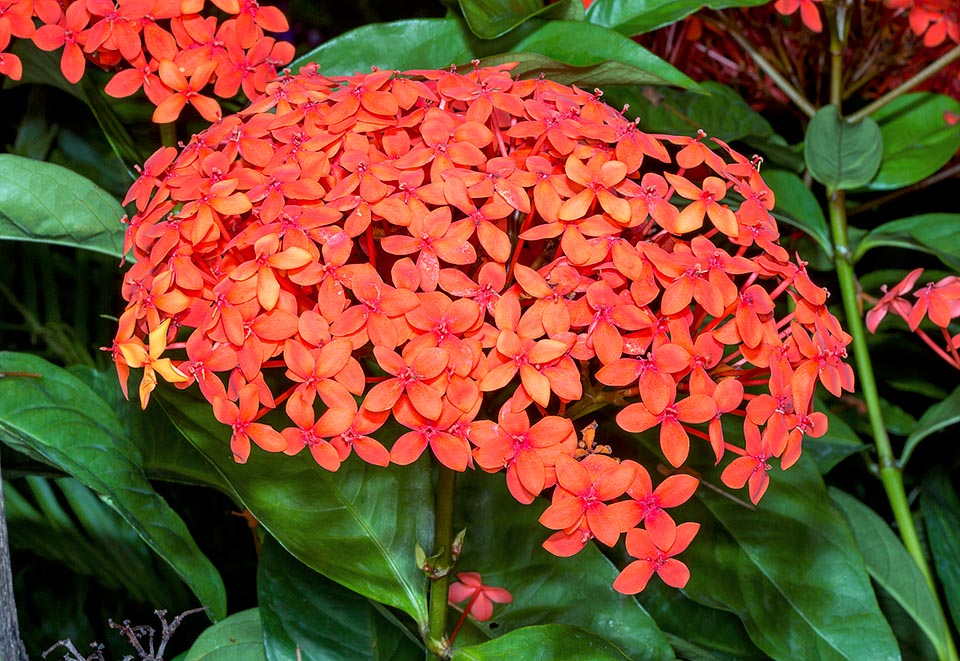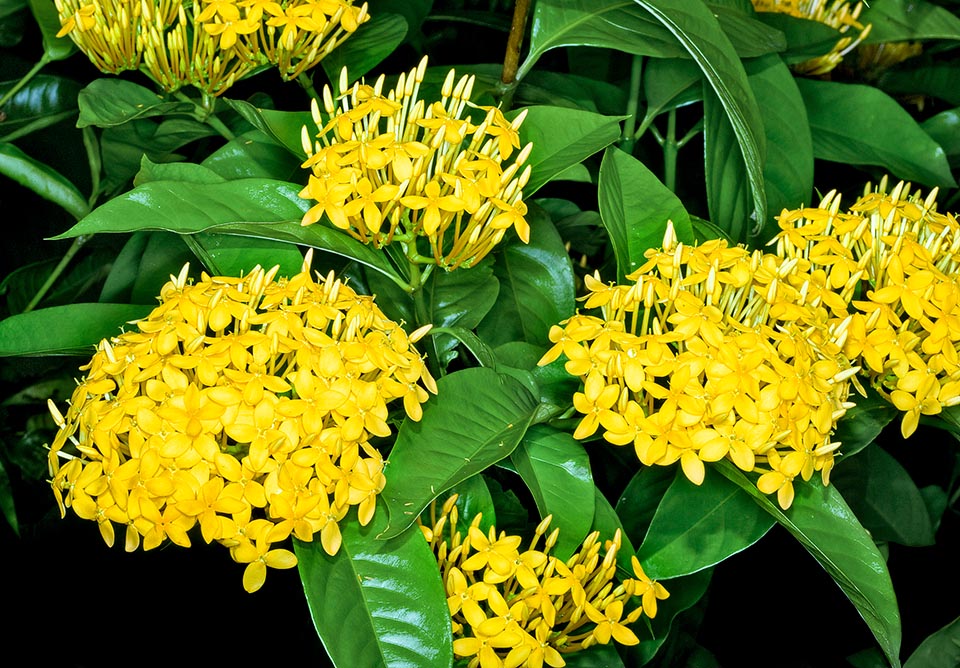Family : Rubiaceae

Text © Pietro Puccio

English translation by Mario Beltramini
Ixora coccinea L. (1753) is native to western and southern India, Sri Lanka, Thailand and Vietnam.
The name of the genus Ixora is probably the phonetic expression of the Sanskrit Ishwara (Shiva), to whom this flower is traditionally offered by the Hindu believers; the name of the species is the Latin word “coccinea” = of scarlet colour, with obvious reference.
Common names: “paranti”, “patali”, “raktala” (Sanskrit); “rangan”, “rugmini”, “ranjan” (Hindi); “techi”, “tetti”, “kattutechi” (Malayalam); “flame of the woods”, “Shiva’s flame”, “jungle geranium”, “jungle flame”, “passionate love”, “burning love” (English); “ixora écarlate” (French); “Ixore”, “Scharlachrote Iora“ (German); “ixora”, “cruz de Malta”, “coralillo”, “coral”, “Santa Rita”, “jazmín del diablo” (Spanish); “ixora”, “ixora-coral”, “cruz de Malta”, “amor ardente”, “ixora vermelha”, “ixora-coral” (Portuguese).

Native to India, Sri Lanka, Thailand and Vietnam, Ixora coccinea is one of the most popular floriferous shrubs in the tropical and subtropical regions © Giuseppe Mazza
The Ixora coccinea is one of the most popular flowering trees in the tropical and subtropical regions; it has been declared, for instance, national flower of Suriname (Dutch Guyana), where it’s called “fajalobi”, due to its ample presence. It prefers soils rich in organic substance, sub-acid, draining and kept humid, and a full sun exposition, for an abundant and continuous blossoming.

Evergreen and compact species, up to about 3 m tall, it bears tirelessly generous scarlet red, orange, pink and yellow inflorescences © Giuseppe Mazza
Synonyms: Pavetta coccinea (L.) Blume (1826): Ixora montana Lour. (1790); Pavetta rubra Noronha (1790); Ixora grandiflora Ker Gawl. (1817); Ixora bandhuca Roxb. (1820); Ixora obovata B.Heyne ex Roth (1821); Ixora arborea Lodd. (1822); Pavetta incarnata Blume (1826); Ixora incarnata (Blume) DC. (1830); Ixora purpurea Fisch. ex Loud. (1830); Ixora propinqua R.Br. ex G.Don, (1834); Pavetta bandhuca Miq. (1857); Ixora coccinea var. bandhuca (Roxb.) Kurz (1877); Ixora coccinea var. linneana Kurz (1877); Ixora radiata var. thomeana K.Schum. (1893); Ixora eekhautii Gentil (1907); Ixora fraseri Gentil (1907); Ixora morsei Gentil (1907); Ixora lutea Hutch. (1912); Ixora coccinea var. aureorosea Corner (1941); Ixora coccinea var. decolorans Corner (1941); Ixora coccinea var. lutea (Hutch.) Corner (1941); Ixora coccinea var. rosea Corner (1941); Ixora thomeana (K.Schum.) G.Taylor (1944); Ixora coccinea var. hermannii Fosberg & Sachet (1989); Ixora coccinea var. intermedia Fosberg & Sachet, (1989); Ixora coccinea f. lutea (Hutch.) Fosberg & Sachet (1989).
→ To appreciate the biodiversity within the RUBIACEAE family please click here.
